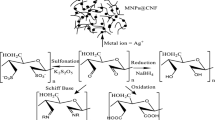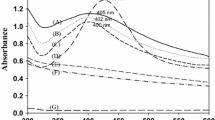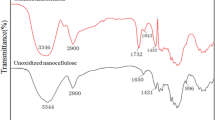Abstract
Bacterial cellulose-based antifouling materials have been produced by incorporation of silver nanoparticles for broad-spectrum antimicrobial activity. Three variations of silver nitrate (AgNO3) to reducing agent concentrations have been tried to vary the silver nanoparticle dimension. The formation of silver nanoparticles was also evidenced by the X-ray diffraction, and the crystallite size was found to decrease with increase in NaBH4 concentration. AgBC composites having < 2% (W/W) of silver exhibited 99.9% antimicrobial activity which was sustained up to 72 h against spoiled food derived mixed microbial culture. On the other hand, only 90% activity was observed with colloidal AgNPs due to aggregate formation. Composites displayed superior antimicrobial activity than colloid with equivalent amount of silver. Food stuff was protected from microbial spoilage for 30 days when stored in AgBC nanocomposites, whereas spoilage was noticed within 15 days for food stuff stored in regular polythene bag. Therefore, the AgBC composite having < 2% silver can be used as a lining of regular food packaging material to extend shelf life till 30 days. Toxicity due to high amount of silver can be prevented with these composites and can be safely used in healthcare applications such as food packaging, wound dressing, hospital bed lining and surgical apparels.











Similar content being viewed by others
References
Van Houdt R, Michiels CW (2010) Biofilm formation and the food industry, a focus on the bacterial outer surface. J Appl Microbiol 109:1117
Pavithra D, Doble M (2008) Biofilm formation, bacterial adhesion and host response on polymeric implants—issues and prevention. Biomed Mater 3:034003
Hota S, Hirji Z, Stockton K et al (2009) Outbreak of multidrug-resistant Pseudomonas aeruginosa colonization and infection secondary to imperfect intensive care unit room design. Infect Control Hosp Epidemiol 30:25
Yu Q, Zhang Y, Wang H, Brash J, Chen H (2011) Anti-fouling bioactive surfaces. Acta Biomater 7:1550
Banerjee I, Pangule RC, Kane RS (2011) Antifouling coatings: recent developments in the design of surfaces that prevent fouling by proteins, bacteria, and marine organisms. Adv Mater 23:690
Liu K, Jiang L (2012) Bio-inspired self-cleaning surfaces. Ann Rev Mater Res 42:231
Stewart PS, Costerton JW (2001) Antibiotic resistance of bacteria in biofilms. Lancet 358:135
De Moura MR, Mattoso LH, Zucolotto V (2012) Development of cellulose-based bactericidal nanocomposites containing silver nanoparticles and their use as active food packaging. J Food Eng 109:520
Llorens A, Lloret E, Picouet PA, Trbojevich R, Fernandez A (2012) Metallic-based micro and nanocomposites in food contact materials and active food packaging. Trends in Food Sci Technol 24:19
Espitia PJP, Soares NdFF, dos Reis Coimbra JS, de Andrade NJ, Cruz RS, Medeiros EAA (2012) Zinc oxide nanoparticles: synthesis, antimicrobial activity and food packaging applications. Food Bioprocess Technol 5:1447
Hannon JC, Kerry J, Cruz-Romero M, Morris M, Cummins E (2015) Advances and challenges for the use of engineered nanoparticles in food contact materials. Trends Food Sci Technol 43:43
Christopher P, Linic S (2008) Engineering selectivity in heterogeneous catalysis: Ag nanowires as selective ethylene epoxidation catalysts. J Am Chem Soc 130:11264
Xiu Z-M, Ma J, Alvarez PJ (2011) Differential effect of common ligands and molecular oxygen on antimicrobial activity of silver nanoparticles versus silver ions. Environ Sci Technol 45:9003
Prabhu S, Poulose EK (2012) Silver nanoparticles: mechanism of antimicrobial action, synthesis, medical applications, and toxicity effects. Int Nano Lett 2:1
RO Becker (1985) Google Patents
H-C Wen, Y-N Lin, S-R Jian, et al. (2007) Journal of Physics: Conference SeriesIOP Publishing
Weir E, Lawlor A, Whelan A, Regan F (2008) The use of nanoparticles in anti-microbial materials and their characterization. Analyst 133:835
Hakim LF, Portman JL, Casper MD, Weimer AW (2005) Aggregation behavior of nanoparticles in fluidized beds. Powder Technol 160:149
Zeng F, Hou C, Wu S, Liu X, Tong Z, Yu S (2007) Silver nanoparticles directly formed on natural macroporous matrix and their anti-microbial activities. Nanotechnology 18:055605
Agarwal S, Wendorff JH, Greiner A (2010) Chemistry on electrospun polymeric nanofibers: merely routine chemistry or a real challenge? Macromol Rapid Commun 31:1317
Khandelwal M, Windle AH, Hessler N (2016) In situ tunability of bacteria produced cellulose by additives in the culture media. J Mater Sci 51:4839. doi:10.1007/s10853-016-9783-0
Maneerung T, Tokura S, Rujiravanit R (2008) Impregnation of silver nanoparticles into bacterial cellulose for antimicrobial wound dressing. Carbohydr Poly 72:43
de Santa Maria LC, Santos AL, Oliveira PC, Barud HS, Messaddeq Y, Ribeiro SJ (2009) Synthesis and characterization of silver nanoparticles impregnated into bacterial cellulose. Mater Lett 63:797
Barud HS, Regiani T, Marques RF, Lustri WR, Messaddeq Y, Ribeiro SJ (2011) Antimicrobial bacterial cellulose-silver nanoparticles composite membranes. J Nanomater 2011:10
Pinto RJ, Marques PA, Neto CP, Trindade T, Daina S, Sadocco P (2009) Antibacterial activity of nanocomposites of silver and bacterial or vegetable cellulosic fibers. Acta Biomater 5:2279
Maddox DA (1998) Implications of new technologies for seed health testing and the worldwide movement of seed. Seed Sci Res 8:277
Bello BO, Ullah H, Olawuyi O, Adebisi O (2016) Microorganisms causing post-harvest tomato (Solanum lycopersicum L.) fruit decay in Nigeria. Scientia 13:93
JHH in’t Veld (1996) Microbial and biochemical spoilage of foods: an overview. Int J Food Microbiol 33:1
Nishiyama Y, Sugiyama J, Chanzy H, Langan P (2003) Crystal structure and hydrogen bonding system in cellulose Iα from synchrotron X-ray and neutron fiber diffraction. J Am Chem Soc 125:14300
Baker C, Pradhan A, Pakstis L, Pochan DJ, Shah SI (2005) Synthesis and antibacterial properties of silver nanoparticles. J Nanosci Nanotechnol 5:244
Sönnichsen C, Franzl T, Wilk T, Von Plessen G, Feldmann J (2002) Plasmon resonances in large noble-metal clusters. New J Phys 4:93
Xu G, Chen Y, Tazawa M, Jin P (2006) Surface plasmon resonance of silver nanoparticles on vanadium dioxide. J Phys Chem B 110:2051
Wu J, Zheng Y, Song W et al (2014) In situ synthesis of silver-nanoparticles/bacterial cellulose composites for slow-released antimicrobial wound dressing. Carbohydr Polym 102:762
Maria L, Santos AL, Oliveira PC et al (2010) Preparation and antibacterial activity of silver nanoparticles impregnated in bacterial cellulose. Polimeros 20:72
Dankovich TA, Gray DG (2011) Bactericidal paper impregnated with silver nanoparticles for point-of-use water treatment. Environm Sci Technol 45:1992
Acknowledgements
Authors acknowledge the financial support of DST-FAST TRACK grant SB/FTP/ETA-0073/2014. Authors also thank Dr. Thiruvengadam from IIT Bombay, Mr Upender Sunkari from IIT Hyderabad for technical support during SEM, TEM and Indian Institute of Technology, Hyderabad for providing necessary research infrastructure to carry out this work.
Author information
Authors and Affiliations
Corresponding author
Ethics declarations
Conflicts of interest
There is no conflicts of interest exist for the authors with the submitted work.
Electronic supplementary material
Below is the link to the electronic supplementary material.
Rights and permissions
About this article
Cite this article
Adepu, S., Khandelwal, M. Broad-spectrum antimicrobial activity of bacterial cellulose silver nanocomposites with sustained release. J Mater Sci 53, 1596–1609 (2018). https://doi.org/10.1007/s10853-017-1638-9
Received:
Accepted:
Published:
Issue Date:
DOI: https://doi.org/10.1007/s10853-017-1638-9




